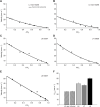Trade-offs in muscle physiology in selectively bred high runner mice
- PMID: 36408738
- PMCID: PMC9789404
- DOI: 10.1242/jeb.244083
Trade-offs in muscle physiology in selectively bred high runner mice
Abstract
A trade-off between locomotor speed and endurance occurs in various taxa, and is thought to be underpinned by a muscle-level trade-off. Among four replicate high runner (HR) lines of mice, selectively bred for voluntary wheel-running behavior, a negative correlation between average running speed and time spent running has evolved. We hypothesize that this trade-off is due to changes in muscle physiology. We studied the HR lines at generation 90, at which time one line (L3) is fixed for the mini-muscle phenotype, another is polymorphic (L6) and the others (L7, L8) lack mini-muscle individuals. We used in situ preparations to quantify the contractile properties of the triceps surae muscle complex. Maximal shortening velocity varied significantly, being lowest in mini-muscle mice (L3 mini=25.2 mm s-1, L6 mini=25.5 mm s-1), highest in normal-muscle mice L6 and L8 (40.4 and 50.3 mm s-1, respectively) and intermediate in normal-muscle L7 mice (37.2 mm s-1). Endurance, measured both as the slope of the decline in force and the proportion of initial force that could be sustained, also varied significantly. The slope was shallowest in mini-muscle mice (L3 mini=-0.00348, L6 mini=-0.00238), steepest in lines L6 and L8 (-0.01676 and -0.01853), and intermediate in L7 (-0.01145). Normalized sustained force was highest in mini-muscle mice (L3 mini=0.98, L6 mini=0.92) and lowest in L8 (0.36). There were significant, negative correlations between velocity and endurance metrics, indicating a muscle-level trade-off. However, this muscle-level trade-off does not seem to underpin the organismal-level speed and endurance trade-off previously reported as the ordering of the lines is reversed: the lines that run the fastest for the least time have the lowest muscle complex velocity and highest endurance.
Keywords: Artificial selection; Endurance; Force–velocity; Locomotion; Muscle physiology; Trade-offs.
© 2022. Published by The Company of Biologists Ltd.
Conflict of interest statement
Competing interests The authors declare no competing or financial interests.
Figures





Similar articles
-
Muscle-Tendon Unit Properties in Mice Bred for High Levels of Voluntary Running: Novel Physiologies, Coadaptation, Trade-Offs, and Multiple Solutions in the Evolution of Endurance Running.Ecol Evol Physiol. 2024 Jul-Aug;97(4):191-208. doi: 10.1086/731307. Epub 2024 Jul 12. Ecol Evol Physiol. 2024. PMID: 39270325
-
Locomotor trade-offs in mice selectively bred for high voluntary wheel running.J Exp Biol. 2009 Aug;212(Pt 16):2612-8. doi: 10.1242/jeb.029058. J Exp Biol. 2009. PMID: 19648406
-
Contractile abilities of normal and "mini" triceps surae muscles from mice (Mus domesticus) selectively bred for high voluntary wheel running.J Appl Physiol (1985). 2005 Oct;99(4):1308-16. doi: 10.1152/japplphysiol.00369.2005. Epub 2005 Jun 9. J Appl Physiol (1985). 2005. PMID: 15947032
-
Glycogen storage and muscle glucose transporters (GLUT-4) of mice selectively bred for high voluntary wheel running.J Exp Biol. 2009 Jan;212(Pt 2):238-48. doi: 10.1242/jeb.025296. J Exp Biol. 2009. PMID: 19112143 Free PMC article.
-
Morphometry, ultrastructure, myosin isoforms, and metabolic capacities of the "mini muscles" favoured by selection for high activity in house mice.Comp Biochem Physiol B Biochem Mol Biol. 2006 Jul;144(3):271-82. doi: 10.1016/j.cbpb.2006.02.009. Epub 2006 Mar 6. Comp Biochem Physiol B Biochem Mol Biol. 2006. PMID: 16707270
Cited by
-
Differing Genetics of Saline and Cocaine Self-Administration in the Hybrid Mouse Diversity Panel.Genes Brain Behav. 2025 Jun;24(3):e70029. doi: 10.1111/gbb.70029. Genes Brain Behav. 2025. PMID: 40527326 Free PMC article.
-
Does the unusual phenomenon of sustained force circumvent the speed-endurance trade-off in the jaw muscle of the southern alligator lizard (Elgaria multicarinata)?J Exp Biol. 2025 Jan 15;228(2):JEB247979. doi: 10.1242/jeb.247979. Epub 2025 Jan 27. J Exp Biol. 2025. PMID: 39690956 Free PMC article.
-
Early-life exercise effects on Achilles tendon in mice selectively bred for high voluntary wheel-running behavior.Physiol Rep. 2025 Aug;13(16):e70515. doi: 10.14814/phy2.70515. Physiol Rep. 2025. PMID: 40827110 Free PMC article.
-
Large changes in detected selection signatures after a selection limit in mice bred for voluntary wheel-running behavior.PLoS One. 2024 Aug 1;19(8):e0306397. doi: 10.1371/journal.pone.0306397. eCollection 2024. PLoS One. 2024. PMID: 39088483 Free PMC article.
-
Differing genetics of saline and cocaine self-administration in the hybrid mouse diversity panel.bioRxiv [Preprint]. 2025 Mar 29:2024.12.04.626933. doi: 10.1101/2024.12.04.626933. bioRxiv. 2025. Update in: Genes Brain Behav. 2025 Jun;24(3):e70029. doi: 10.1111/gbb.70029. PMID: 39713377 Free PMC article. Updated. Preprint.
References
-
- Ackerly, D. D., Dudley, S. A., Sultan, S. E., Schmitt, J., Coleman, J. S., Linder, C. R., Sandquist, D. R., Geber, M. A., Evans, A. S., Dawson, T. E.et al. (2000). The evolution of plant ecophysiological traits: recent advances and future directions. Bioscience 50, 979. 10.1641/0006-3568(2000)050[0979:TEOPET]2.0.CO;2 - DOI
Publication types
MeSH terms
LinkOut - more resources
Full Text Sources

